Canning Stock Route Expedition - seat in vehicle
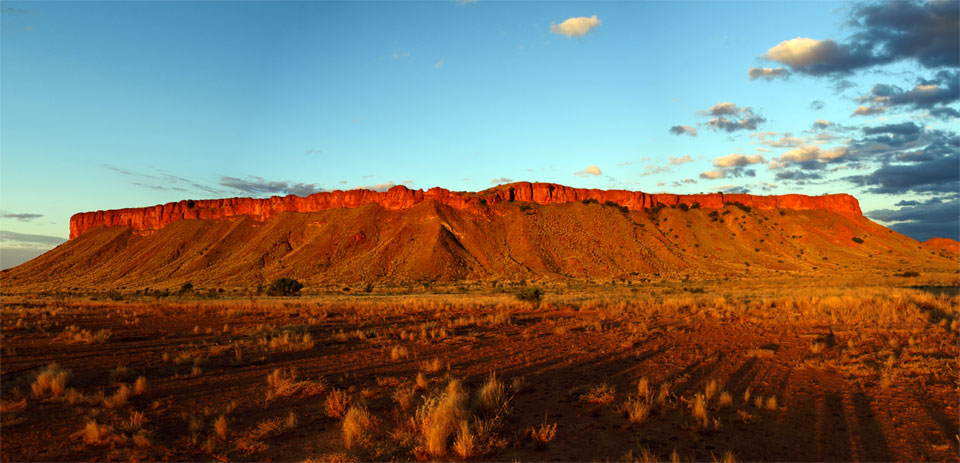

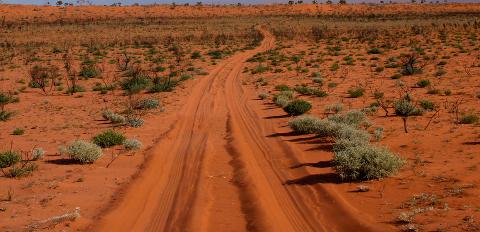

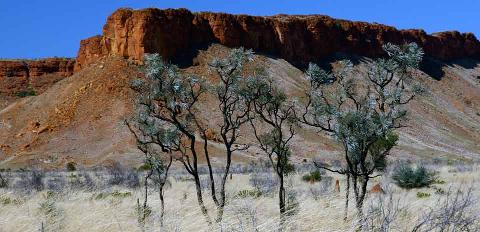
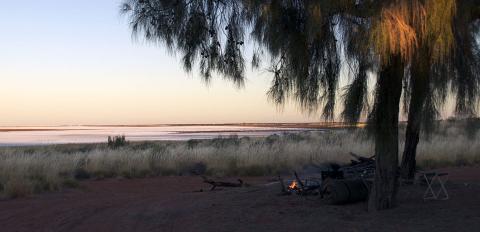
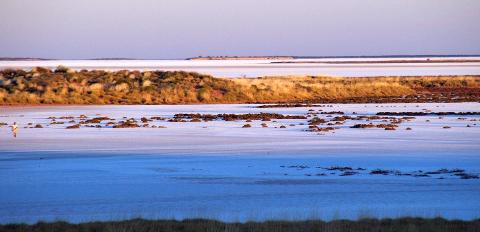

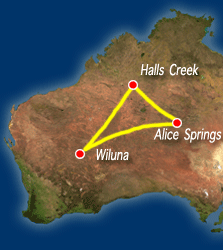
- Duração: 19 Dias (Aproximadamente)
- Código de produto: csr
Diamantina has been leading the way on the Canning Stock Route since 1992, earning our reputation as the acknowledged and recognised experts in this remote and challenging terrain.
Itinerary
Day One
Embarking on our adventure, we pick you up at your Alice Springs hotel. Our route leads us northward along the Tanami Road, soon crossing the Tropic of Capricorn. Our first pitstop is at Tilmouth Well, for morning tea.Wee visit Warlukalangu Art Centre at Yuendemu, the largest Aboriginal art centre in Central Australia before breaking for our first lunch at Chilla Well, setting the stage for an extraordinary encounter with the fascinating world of termites. As we venture deeper into the heart of the Tanami Desert, a sprawling landscape of remarkable termite mounds unfolds before our eyes. Some of these mounds are so tightly clustered that they resemble a bustling cityscape of skyscrapers, creating a mesmerising sight. Our adventure takes us through Rabbit Flat, and we conclude our day's journey by setting up camp, just shy of the Western Australian border. This is where we can unwind and savor the unique serenity of the Tanami Desert.
Day Two
Crossing into Western Australia, we visit the Aboriginal community of Balgo and explore the internationally renowned Warlayirti Art Centre. We discover the striking escarpment overlooking the Balgo Pound, where we are treated to astonishing panoramic vistas that will leave you breathless. We lunch at Sturt Creek, offering a moment of tranquil relaxation next to a waterhole. Later, we venture to the remarkable Wolfe Creek meteorite crater, formed less than 120,000 years ago when a 14,000 tonne meteor crashed into the earth creating the second largest crater on earth. Aboriginal people call it Kandimalal. As the day concludes, we camp among the northern coolibah trees on the floodplain of Sturt Creek. It's a perfect spot to appreciate the tranquil ambiance of the Australian outback.
Day Three
The day commences taking on fuel at Billiluna Aboriginal Community, the last fuel for 800km. We commence our expedition along the Canning Stock Route following the west bank of Sturt Creek down to the vast Paruku - Lake Gregory wetlands. Keep an eye out here for flocks of Brolga. Shortly we arrive at Well 51, also known as Weriaddo- the final well constructed by Canning, undertaken amidst tremendous adversity. Well 51 is nearby to the "Delivery Camp," where cattle drovers would take charge of the herds to begin their southward journey. The old station tracks we've been following gradually transition into mere wheel tracks etched into the sandy terrain. We pause for lunch on a red clay pan punctuated with stunted northern coolibah trees near Well 50. Post-lunch, we pay a visit to Well 49, where we encounter a poignant tale at the solitary grave of the drovers' cook, Jack Smith. Our exploration also unveils an expansive Aboriginal stone tool site, providing a window into the ancient history of the region. Our day concludes as we set up camp in the vicinity of the striking Breaden Hills, with their dramatic, red-torn cliffs serving as a breathtaking backdrop. This majestic landscape glows red in the sunset followed by a starry outback sky.
Day Four
Our morning adventure unfolds as we journey across the spectacular Southesk Tablelands, a humbling expanse of extensive plains crowned by flat-topped mesas. Along the way, we find ourselves stopping atop one of these mesas, allowing us to absorb the surreal grandeur of this remarkable region. The panoramic view from this vantage point is bound to leave an indelible impression. We continue on to the ruins of Well 47, and after a break encounter our first sandhills en route to Well 46, on a scenic flat dotted with the striking white trunks of the northern coolibah trees. We depart from the Shire of Halls Creek at the ruins of Well 45, our journey leads us to the shores of Gravity Lakes, where we make camp for the night.Day Five
Our day's journey commences with an exploration of a hillside adorned with caves housing Aboriginal paintings. Continuing our adventure, we soon arrive at Pijallinga clay pan, a location that carries a fascinating historical anecdote. During the arduous journey of the construction party, the usually dry clay pan became a haven for a profusion of birdlife. To motivate the weary men who had been subsisting on a meager diet of rationed flour and water, the second in charge, Trotman, promised them a wild duck feast. Over-indulgence led to violent illness. Turning our sights southward, we venture into the expanse of the Great Sandy Desert. Our route aligns with an abandoned seismic track, leading us over some imposing dunes to reach the burnt out remains of Well 44. We pause for lunch amidst a stand of flourishing Melaleuca trees at Well 43. The shade here offers a rejuvenating break in our travels. A short drive brings us to Guli Lake, a striking dry samphire plain. At the lake's southern end, Canning utilised a natural spring to create Water Tank 42. The upcoming leg of our expedition brings us face to face with the stock route's highest sand dunes. The track was cut by surveyor Harry Johnson in 1962, and he pushed it over the highest points to locate his trig stations. We conclude our day's journey at Well 41, setting up camp in the midst of a dense grove of Melaleuca trees - the perfect backdrop for a serene and peaceful night in the desert.
Day Six
Our journey continues as we head southward to the remains of Well 40. A short distance from the well, on top of a sandhill, lies the poignant grave of Michael Tobin, a member of Canning's 1907 Survey Party, who tragically met his end when speared by an Aboriginal. This solitary grave serves as a solemn reminder that this region was, until relatively recently, very much a frontier. In a recent development, the Martu people have added another grave to this landscape, commemorating Mungkututu, the Aboriginal who threw the spear that led to Tobin's death, only to be shot in return. Our journey takes us across Lake Tobin, and southward to Water 38, also known as Wardabunni Rockhole. This region is graced with gnamma holes,the rock surfaces bear ancient petroglyphs, and the carved names of drovers provide an intriguing glimpse into the past. Further south we reach Well 37, colloquially referred to as the 'Haunted Well.' This name carries with it a chilling history, as it is associated with several graves of drovers and prospectors who met their fates, some speared and others bludgeoned by Aboriginals. Here, we pause to listen to the tales of these initial encounters and the harrowing events that ensued, including the Police Punitive Expeditions led by Sgt. Pilmer in response to these incidents. Beyond the haunted well, we venture into the region that Canning aptly named the "Great Oak Forest." This is where we make camp beneath the desert oaks, their needles gently whispering in the night breeze.
Day Seven
The portion of our route from Well 37 to Well 36 takes us along the crests of the sand dunes. This section of the journey came into existence following the significant floods of 2002, a reminder of the ever-changing nature of the landscape. Beyond Well 35, the sand hills gradually recede, offering a more open expanse as we make our way to Well 33- the birthplace of the renowned Aboriginal artist Rover Thomas, an influential figure in the world of Indigenous art. Our next stop is Kunawaritji Community, a pivotal point in our adventure. Here, we refuel for the upcoming leg of our journey and savour the luxury of a hot shower. Additionally, the community store presents an opportunity for some retail therapy, the only store on the stock route. Reinvigorated and replenished, our convoy heads southward to our campsite, located near Well 31.Day Eight
Our first pause is at Well 30, sited amongst majestic Bloodwood trees. Continuing southward, we soon encounter Thring Rock, an imposing sandstone outcrop that rises from the surrounding sandhills. A brief but rewarding climb to the summit offers a panoramic reward: breathtaking views of the encompassing countryside. To the west, the shimmering expanse of Lake Auld, a vast salt lake, stretches into the distance. Notably, surveyor and explorer Larry Wells played a role in naming the various landmarks in this area during the ill-fated Calvert Expedition, drawing inspiration from members of John McDouall Stuart's pioneering party, who first traversed the continent. As we journey onward, we reach Well 29, a site now reduced to mere remnants. Well 28 has vanished without a trace, and only a few rusted troughs and weathered timbers mark the remnants of Well 27. Our day concludes with the choice of camping in a magnificent natural amphitheater nestled within the Slate Range. Here, you may be fortunate enough to spot the elusive black-flanked rock wallabies that inhabit the range.
Day Nine
Our journey continues as we make our way to Teiwa Well (Well 26), a significant landmark that underwent complete reconstruction in 1983. This restoration offers a vivid glimpse into what these wells would have originally been like in their pristine condition, providing valuable insight into their historical significance. Shortly, the Canning Stock Route converges with the Talawana Track, a connection that extends for 450 kilometers to the west, leading eventually to Newman. The Talawana Track, a remarkable route that was initially surveyed by the legendary Len Beadell and then constructed by his Gunbarrel Road Construction Party, forms part of the vital network of roads serving the Woomera Range. We replenish our vehicle's tanks with pure water from Georgia Bore, which was drilled by CRA and named after the daughter of one of the geologists. This refreshing stop equips us for the final leg of our day's journey. Our day concludes as we arrive at our campsite near the banks of Lake Disappointment. From this vantage point, we are treated to a spectacular vista that overlooks the mesmerizing salt expanse of Lake Disappointment.
Day Ten
Past impressive groves of Desert Oak trees and giant termite mounds, our journey unfolds, leading us to the picturesque but highly saline Savory Creek. If the creek has been flowing it can present a boggy challenge to cross. Our adventure continues southward, and we eventually pause for lunch in the dunes near the Tropic of Capricorn. In the afternoon, our path leads us further south to the Durba Hills, an imposing geological formation. Here, we track eastwards along the northern slopes of the range, passing by colossal boulders that have tumbled from the escarpment. Nestled discreetly within this range is the hidden treasure of Durba Springs, a site that was described by Dick Smith as one of the most captivating places in all of Australia. The Drovers of old recognised its natural bowl-like shape and utilised it as an ideal spot for cattle camps. Wally Dowling built yards here in the 1940s that have long disappeared. Our evening finds us setting up camp amidst soft grass beneath the welcoming shade of river red gums, an idyllic setting that invites relaxation and appreciation of the natural beauty that surrounds us. We are fortunate to spend two nights at Durba, allowing ample time to savor this stunning location and uncover its hidden gems during our exploration.
Day Eleven
A day off in magnificent Durba. We offer the option of joining us on a guided walk to view rock art galleries and petroglyph sites to the east of the gorge. In the afternoon you are free to relax, or explore the pools in the upper gorge.
Day Twelve
Our journey resumes as we bid farewell to the enchanting Durba and set our course southward, trailing along the western flanks of the Durba Hills. We have a brief stop at Well 16. Our exploration takes us further down to Well 15, a site where we delve into the captivating tale of Joe Wilkins and the murder that transpired near here. The historical narratives that echo through these desert landscapes are an integral part of the Canning Stock Route experience. A brief stopover at Well 14 we continue down to Well 13, where we break for lunch. Post-lunch, we continue our expedition and make our way to Well 12, where we take advantage of the opportunity to fill our water tanks in preparation for the next leg of our adventure. We reach the mesmerising salt Lake Aerodrome, a stark contrast to the dunes and desert oaks of our earlier journey. From this point, we descend to Well 11, known as Goodwin Soak, a name that pays homage to a helpful bank manager in Wiluna. As we move forward, the environment around us undergoes a transformation as we enter the Gascoyne bio-region. Here, the sand dunes and desert oaks give way to Mulga woodlands. In the event of recent rains, this area bursts to life with an array of wildflowers, carpeting the landscape with vibrant colors. Our day culminates as we establish our camp near Well 10, nestled amidst the scenic beauty of mulga woodlands.Day Thirteen
Our southward journey leads us into station country, a captivating transition from the earlier desert landscapes. As we press on, we reach Well 9, a site of historical significance where the remnants of a stone fort stand as a testament to the past. This fort was constructed in 1874 by the intrepid explorer and later Western Australian Premier, John Forrest, with the purpose of safeguarding his expedition against attack from Aboriginals. Continuing on our path, we traverse the remarkable Ingebong Hills, pine clad granite ranges that add to the scenic variety of our journey. Our next destination is Well 6, located at Pierre Springs. Here, the well has been reconditioned and is enveloped by the grandeur of white-trunked river red gums. This tranquil setting provides an ideal location for our campsite.
Day Fourteen
Our journey continues shortly after our departure from Pierre Springs, and we're treated to a breathtaking sight as we encounter a magnificent stand of Grass Trees, scientifically known as Xanthorrhoea preissii. These extraordinary plants, neither truly grass nor trees, are a visual delight, boasting a unique and captivating appearance that adds to the wonder of our adventure. Our next stop is at Well 5- the deepest well along the entire stock route. Canning's construction crew accomplished the impressive feat of sinking this well through solid rock to a staggering depth of 31 meters. We follow the path of Kennedy Creek, leading us southward past Well 4b to the remarkable Windich Springs. This is a stunning oasis, a sprawling sheet of water that extends for nearly 400 meters, enclosed by the towering presence of majestic river red gums. You may even be lucky enough to see Dinner Plate Tortoises, adding a touch of wildlife wonder to our day's adventures. On the eastern bank of the springs, we can appreciate a substantial rock wall built by Aboriginals, once used for hunting game. Continuing our southward course, we cross the Frere Range via Snell's Pass and skirt the shores of Lake Nabberu. Our path leads us to Well 3, and from there, we progress to our campsite near Well 2A, a region characterised by magnificent granite landscapes. It's a fitting location to savour our final night on the Canning Stock Route.Day Fifteen
At Well 2, our journey takes a significant turn as we bid farewell to the familiar wheel tracks we've followed for nearly two weeks. We hit an exhilarating speed of 100 kilometres per hour on the North Willuna Road, a welcome taste of civilization after our remote and rugged adventures. Our first stop is the town of Willuna, in the northern goldfields, providing us with a touch of luxury and modern comforts. At the newly constructed caravan park, we indulge in the sheer bliss of a hot shower. Retail therapy awaits at the local IGA, where we can browse for treasures to commemorate our journey. A visit to the Tjukurba Art Gallery and museum in the charming old bush nursing hospital enriches our experience, offering a glimpse into the history and culture of the region. Our next leg leads us eastward, venturing towards the renowned Gunbarrel Highway.
Day Sixteen
Shortly after breaking camp we visit an old stockman's camp at Harry Johnson Water, a glimpse into the bygone era of cattle droving and station life. We make a stop at Carnegie Station, a place where a small museum enriches our understanding of the region's history. Here, we fill our tanks with fresh water in preparation for the upcoming journey along the iconic Gunbarrel Highway. Our adventure takes us further east, soon departing station country as we journey into the heart of the Gibson Desert. Along the way, we ascend Mt Nossiter, allowing us to marvel at the breathtaking views before descending to the spectacular Mungilli Clayton, a RAMSAR wetland of ecological importance. Continuing our path along the Gunbarrel, we find our campsite near Mt Everard.
Day Seventeen
From camp we travel to Everard Junction. From here the Gary Highway, another Beadell road heads north. A short walk brings us to the top of Mt. Everard, affording spectacular views of the Gibson Desert. The track is very rocky and rough as it turns southward toward Mt. Beadell. Here you can climb to the top which houses a memorial theodolite to Len Beadell. We continue on past Notabilis Hill to our camp near Mt. Samuel.
Day Eighteen
From our camp on the Heather Highway we make our way to the Great Central Road and onward to Warburton. Immerse yourself in Aboriginal artwork at the Tjulyuru Regional Art Gallery, the centre of Ngaanyatjarra art. Continuing our adventure, we head north to Warakurna, where we visit Australia's most remote weather station, the Giles Meteorological Station. We visit the Warakurna Roadhouse, housing the Warakurna Artists Gallery. Journeying further, we reach the convergence of the Gunbarrel Highway and the Sandy Blight Junction Road, culminating in our final night's camp beneath the awe-inspiring buttress cliffs of the Schwerin Mural Crescent.
Day Nineteen
In the early hours of our final day, we cross the border from Western Australia into the Northern Territory. A visit to Lasseter's Cave brings us face to face with a place where the explorer, with scant supplies, sought refuge before embarking on the fateful journey into the unforgiving desert that lead to his death. Our ascent of a sand hill, provides us with a spectacular western view of Kata Tjuta. We journey onward to Yulara, where those leaving us here can be dropped at their hotels or the airport. The convoy then continues eastward along the Lasseter Highway, leading us to Erldunda Roadhouse. From there, we head north along the Stuart Highway, culminating in our arrival in Alice Springs late in the afternoon.




